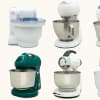Best Method for Kneading Bread Dough
These days almost all recipes for bread seem to call for a stand mixer. Does old-fashioned kneading hold any advantages?
While kneading by hand can be a gratifying process, most of our recipes call for a stand mixer simply because it’s easier. (And in cases where the dough is extremely wet and loose—as in our Ciabatta or Pizza Bianca—working it by hand is virtually impossible.) But to answer your question, we rolled up our sleeves and laboriously kneaded batches of challah, multigrain, and olive bread by hand for 10 minutes and kneaded second batches of each in stand mixers fitted with dough hooks for the same amount of time. While all of the loaves were equally light, we found the handmade breads chewier (an indication of greater gluten development) than the machine-made samples.
Our science editor explained: While gluten (the interlinked protein strands that give bread structure) develops no matter how you mix the dough, machine-kneading is rougher; it links gluten strands only to tear them apart. Hand-kneading is gentler, producing gluten that, once formed, stays together, which can ultimately lead to chewier texture.
Still, the differences weren’t dramatic enough for us to lock away our stand mixer and revert to hand-kneading. It’s just too convenient to let a machine do it for you.



